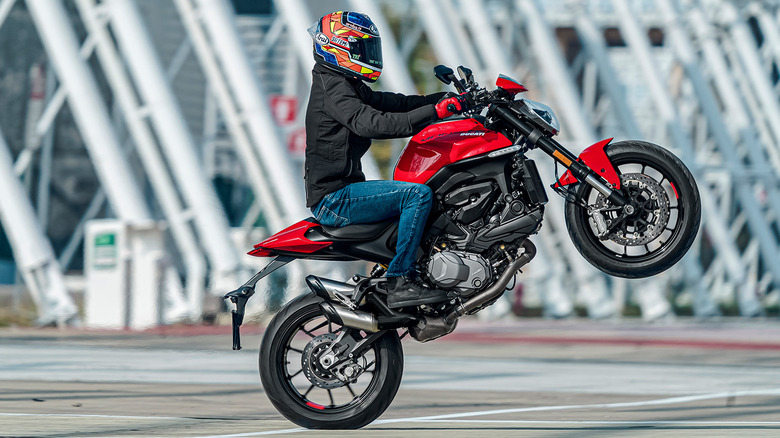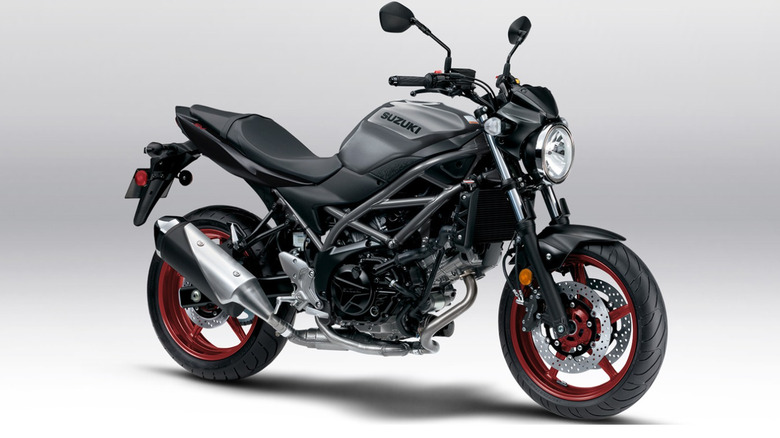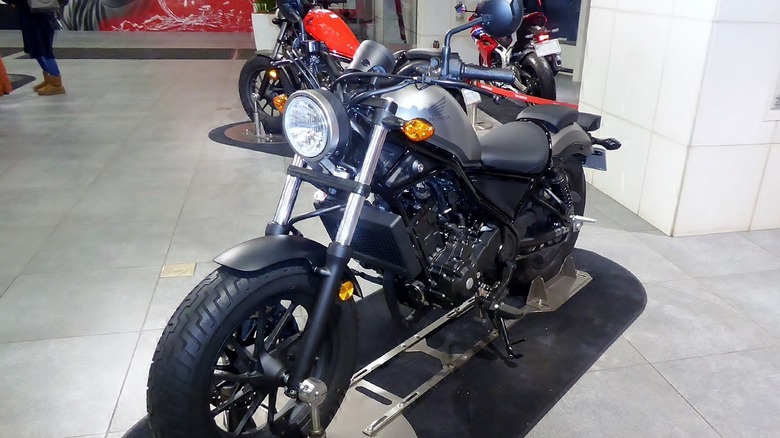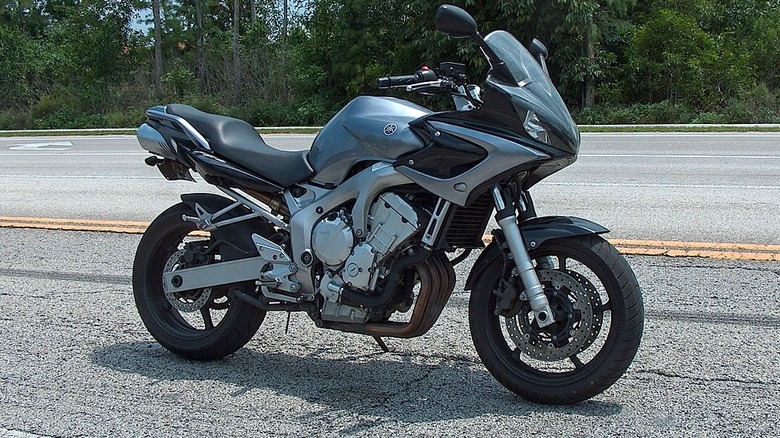10 Motorcycles With The Lowest Maintenance Costs
Motorcycles fill an interesting niche in the realm of American transportation. They are considered "toys" to some, but to others, a bike can be their primary mode of transport, or a secondary vehicle they use exclusively for their commute to save on gas. Either way, the last thing anyone wants is to deal with mechanical issues when they just want to go for a ride.
Reliability is one of the biggest issues with motorcycles, but there's not a lot of info out there on which bikes require the least amount of maintenance. While all of them need regular maintenance like oil changes, some brands and bikes are notorious for spending as much time in the shop as they do on the road. SlashGear published a survey on reliability early in 2023 with some surprising results, and another common reference point for brand reliability is a 2015 survey done by Consumer Reports. Combining those reference points and doing some research into the brands mentioned, results in this list of some of the most reliable, low-maintenance bikes available.
Royal Enfield
Royal Enfield is an anomaly, as its new bikes share the classic styling of its hundred-plus-year history while improving on the issues that those same cycles were plagued with. As a company, it's been manufacturing motorcycles since 1901, although its current incarnation as an India-based manufacturer began in 1949. The best-known model it produced, the Bullet, was around from 1932 until 2020, and due to very little competition in its native India, it hadn't really changed a lot from a design perspective. When production on the Bullet 500 ended, many called it the end of an era, although the venerable machine had its share of issues.
The death of the Bullet was short-lived, however, as the Royal Enfield Classic 350 retains a lot of the style of the Bullet C5 Classic while improving on its shortcomings. It's no powerhouse or speed demon, and it's not meant to be. A 349cc, two-valve, fuel-injected single with a five-speed gearbox is the heart of this stylish ride. The sub-$5,000 price tag is reasonable for a nice-looking motorcycle that tops out at around 75 mph but is more comfortable around 55-60. It's great for city riding, which makes sense when you see footage of classic Bullets zipping around people, cars, and livestock in its home country.
Good, nimble handling and middle-of-the-road brakes and ride quality (and a three-year, unlimited mileage warranty when purchased new) make the Classic 350 a reliable, low-cost, low-maintenance addition to Royal Enfield's lineage.
Indian (and Polaris, R.I.P.)
The first American motorcycle company, Indian was relaunched by new owners Polaris Industries in 2011 after a 50-year hiatus in production and several attempts by others to use Indian branding and imported bikes. The current iteration of the company has a good lineup of popular motorcycles, including the Chieftain, Challenger, and Roadmaster. Like many of the manufacturers on our list, it has also started producing a pair of electric bikes, which might end up replacing our current low-maintenance pick for the brand.
Indian promotes do-it-yourself maintenance on its website, providing plenty of helpful articles and videos for those comfortable with a wrench. The company's Scout Bobber Sixty, one of the most popular names in their resurrected lineup, only calls for an oil change every 10,000 miles. Obviously, regular inspections are key to keeping any vehicle on the road, and periodic maintenance is always recommended — even if only to have an experienced technician inspect the bike — but if properly cared for, the Scout Bobber Sixty can likely last as long as its owner.
Victory Motorcycles, also owned by Polaris, was shuttered in 2017 after only 18 years of production as an alternative to Harley-Davidson. However, the company's bikes are still going strong, and the Cross Country is one of the most low-maintenance and reliable baggers out there. Victory ranked fifth in the Consumer Reports survey, and the CC Tour Deluxe, in particular, is fondly remembered by Victory owners as a bulletproof bike.
BMW
It's hard to believe anything with the BMW badge can be described as "low-maintenance." The company's cars are pricey, luxurious vehicles produced with the finest German engineering. However, BMW's motorcycles don't quite have that same pedigree. Sure, they're good looking bikes, but they ranked next-to-last in that Consumer Reports survey, and didn't even make SlashGear's list. Still, many owners swear by the reliability of their personal bikes despite a reported 40% of surveyed owners from 2008-2014 experiencing a "major failure," and brand loyalty can blind some riders to the real costs of their hobby.
However, there is one standout in the BMW Motorrad lineup: the R nine T Pure. It's a great looking cruiser that combines a classic design with BMW flair, and maintaining it is said to be more affordable than most BMW motorcycles. It's a barebones bike — even a tachometer and gear position sensor aren't included — but the air-cooled boxer engine is beloved by many of BMW's fans.
The G310 GS is another BMW motorcycle known as a gateway for new riders, and the relatively low price and easy-to-maintain single-cylinder engine make it a great first adventure bike.
Ducati
While we're on the subject of European bikes, Italian manufacturer Ducati often gets a bad rap as a maker of unreliable motorcycles. It ranked pretty low on that Consumer Reports survey we've been referring to with a 33% failure rate, although Ducati did tie for a distant second place on SlashGear's own survey. There are some issues with plastic fuel tank swelling and common clutch issues across all models. Overall, Ducati just seems more interested in making high-powered, fast bikes than ones with an eye toward reliability and low maintenance, as evidenced in the success of its many racing bikes.
Even with that fast-first mindset, the Ducati Monster and its L-twin engine is considered the most dependable bike that Ducati has manufactured, and in the years since the Monster's debut in 1993, the air-cooled engine design has only improved. However, while overall the motorcycle is relatively low maintenance, the desmodromic valves on the Monster require adjustment every 7,500 miles, a service that can be pricey at the dealer and difficult to perform at home.
Triumph
Like Royal Enfield and Indian, Triumph is a badge with a long history, although its current iteration was founded in 1983. The British-based manufacturer has technically been around since the early 1900s and was resurrected from bankruptcy as Triumph Motorcycles Ltd. When the company was reborn, it made a point to slowly reintroduce and redesign several of the company's iconic names for a new generation of riders. In doing so, Triumph addressed many of the issues that plagued its bikes — making the new versions some of the most reliable and easy to maintain in the brand's history.
The first Triumph motorcycle many think of is the Bonneville. The classic British bike was featured in the film "The Great Escape," and when it was finally reintroduced in 2000, its recognizable style and fantastic styling won many Triumph enthusiasts over. It's also one of the more reliable motorcycles out there, as the parallel twin in the Bonneville T120 isn't terribly stressed by over-exertion. Service intervals are every 10,000 miles or annually, and the bikes feature several modern comforts like LCD displays, an under-seat USB charging socket, and LED lights. The Street Twin 900, a bike that shares a lot of the same components as the Bonnie, is another highly recommended Triumph when it comes to reliability and minimal maintenance, although Triumph renamed it the Speed Twin 900 in 2022.
Kawasaki
Japanese bikes have a reputation for being reliable and low-maintenance, and Kawasaki is no exception. With a low 15% failure rate on Consumer Reports' survey, and fourth place on SlashGear's reliability survey, Kawasaki lands solidly in the middle of our list. Kawasaki's diverse lineup features aggressive, sharp angles and a long history of speedy, high-performance bikes starting with 1984's beloved GPz900R, the first of the Ninja line. But the brand has plenty of diversity as well — its Vulcan line of cruisers, naked Zs, and dual-sport KLXs offer something for every rider.
Kawasaki has plenty of bikes that can be counted on for reliability and minimal upkeep. Fans mention the Concours 14 and the Ninja 650 when they discuss Kawasaki motorcycles that are considered "bulletproof." The Concours 14 is a stylish sport-touring motorcycle, while the Ninja 650 is probably Kawasaki's best-known bike. Both feature maintenance schedules around 7,500 miles after the first year, and when properly maintained owners boast lifelong relationships with their older Kawasakis.
Ninjas, especially, are touted as being great for beginners looking to learn how to maintain their bikes as well as ride, as their relatively simple design allows for easier DIY services like chain maintenance and oil changes. Keeping up with those regular, annual chores can keep a Ninja running for years to come.
Suzuki
Suzuki is a Japanese manufacturer that's more well-known for its motorcycles than cars, Sidekick notwithstanding. The company began life as a weaving loom manufacturer in 1909, transitioning to motorcycles in the 1950s. By 1953, Suzuki was producing 6,000 bikes a month, and today Suzuki produces cars, ATVs, and even outboard motors for boats.
High-performance rockets with cool names like the Hayabusa and Katana are Suzuki's top-of-the-line speedsters, and the brand takes a lot of pride in its racing division, but the company also makes a number of cruisers, dirtbikes, and adventure motorcycles. Those are generally considered reliable, affordable, and easy to maintain, with the discontinued Boulevard S40 cruiser and SV650 topping the list of low-maintenance, high-reliability options.
The SV650 is a smaller, naked bike that's recommended for beginners while still maintaining its appeal for experienced riders. The 2003-2009 models, after the carburetors were removed but before the Gladius generation of SV650s, are some of the more sought-after Suzikis because of their hardiness and general ease of operation. However, even more recent models like the 2023 pictured above have great reviews and, at under $8,000, won't break the bank on initial purchase or maintenance.
Harley-Davidson
The brand most Americans think of when they think of a motorcycle is Harley-Davidson. SlashGear's reliability survey put Harleys at a whopping 49.59% — more than double the two brands tied for second — despite landing at sixth place in Consumer Reports' survey with a 26% failure rate.
While other riders may tend to look down on Harley-Davidson enthusiasts for getting the "popular" bike, there are plenty of reasons to pick a Harley apart from brand recognition. The company's touring bikes are second to none, and the added weight can be an advantage on longer road trips. Parts are available en masse — the physical catalog from aftermarket parts specialists J&P Cycle is literally twice the size of the book for every other manufacturer combined. Dealerships are everywhere as well as independent shops, so if one gets into trouble on that cross-country excursion, there's more than likely a nearby mechanic willing to help get riders back on the road. The company will even literally rebuild your engine for you if you're willing to ship it to Milwaukee!
The Harley-Davidson Sportster is known for being one of the most reliable hogs, and the fact that the 883s have the belt-driven Evo motor just means one less thing to worry about. They're also considered some of the easiest Harleys to work on, and if one is looking to save some money there are almost always several to choose from in the aftermarket. One piece of advice: find one that's as close to stock as possible, as one never knows the experience level of previous owners.
Honda
Renowned Japanese automaker Honda got its start with small engines that were attached to bicycles, and since 1948, the company hasn't stopped, having produced over 300 million bikes by the end of 2014. It is widely considered one of the most reliable brands; however, our readers may note that despite a very high Consumer Reports ranking of second place in reliability (tied with Suzuki), the brand doesn't even appear on the list of responses to SlashGear's survey. This may be a combination of brand loyalty or simply an audience that isn't buying what Honda's selling — a common complaint about Honda is that the offerings aren't as stylish or visually pleasing as the bikes that its competitors produce.
Regardless, Honda's range of motorcycles is constantly mentioned as one of the most dependable in the world. The Honda Rebel 250, pictured above, is dependable and easy to maintain despite a suggested service schedule of 4,000 miles per oil change; the Rebel is actually considered so beginner-friendly that many training programs feature them. The RC51 is a Ducati competitor with 136 horsepower in a twin-cylinder motor that's reliable, powerful, and a great heart for a superbike. And the mighty Gold Wing is considered not only one of the most reliable Hondas, but one of the best touring motorcycles on the road.
[Featured image by Tokumeigakarinoaoshima via Wikimedia Commons | Cropped and scaled | CC BY-SA 4.0]
Yamaha
At the top of Consumer Reports' brand reliability survey was Yamaha, leading four Japanese motorcycle companies in riders' trust. Yamaha also landed third on SlashGears' survey, and combined, that's good enough to land them the last spot on our list. Yamaha's reliability and durability are unmatched, and its wide range of bikes that enthusiasts rave about is notable. From older rides like the nimble V-Star 250 to the bobber style Bolt and the beloved FZ1, there's a Yamaha out there for nearly every taste, and even used models are thought to be some of the most reliable — assuming the former owners kept up with regular maintenance.
The Yamaha FZ6, produced from 2004-2009, is considered Yamaha's standard-bearer as a reliable, "bulletproof" street bike for both beginners and enthusiasts. The detuned R6 engine in the Yamaha FZ6 is incredibly reliable with a solid engine that rarely fails, and the bikes are still easy to find if one is willing to look. Another solid bike, the V-Star 650, is larger than the FZ6 but still easy to keep on the road forever when properly maintained.
[Featured image by Trougnouf via Wikimedia Commons | Cropped and scaled | CCA 4.0]










